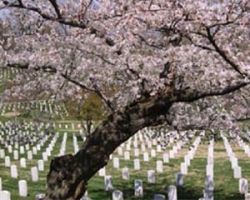Veterans Day originated as “Armistice Day” on Nov. 11, 1919, the first anniversary of the end of World War I. Congress passed a resolution in 1926 for an annual observance, and Nov. 11 became a national holiday beginning in 1938. President Dwight D. Eisenhower signed legislation in 1954 to change the name to Veterans Day as a way to honor those who served in all American wars. The day honors military veterans with parades and speeches across the nation. A national ceremony takes place at the Tomb of the Unknowns at Arlington National Cemetery in Virginia. The following information comes from the U.S. Census Bureau unless noted otherwise.
Veterans
21.8 million—the number of military veterans in the United States in 2010.
Source: 2010 American Community Survey
1.6 million—the number of female veterans in 2010.
2.4 million—the number of black veterans in 2010. Additionally, 1.2 million veterans were Hispanic; 265,000 were Asian; 156,000 were American Indian or Alaska Native; 28,000 were Native Hawaiian or Other Pacific Islander; and 17.5 million were non-Hispanic white. (The numbers for blacks, Asians, American Indians and Alaska Natives, Native Hawaiians and Other Pacific Islanders, and non-Hispanic whites cover only those reporting a single race.)
9 million—the number of veterans 65 and older in 2010. At the other end of the age spectrum, 1.7 million were younger than 35.
When They Served
7.6 million—the number of Vietnam-era veterans in 2010. Thirty-five percent of all living veterans served during this time (1964-1975). In addition, 4.8 million served during the Gulf War (representing service from Aug. 2, 1990, to present); 2.1 million in World War II (1941-1945); 2.6 million in the Korean War (1950-1953); and 5.5 million in peacetime only.
49,500—number of living veterans in 2010 who served during the Vietnam era and both Gulf War eras and no other period.
Other living veterans in 2010 who served during three wars:
- 54,000 served during World War II, the Korean War and the Vietnam era.
Living veterans in 2010 who served during two wars and no other period:
- 837,000 served during both Gulf War eras.
- 211,000 served during both the Korean War and the Vietnam era.
- 147,000 served during both World War II and the Korean War.
Where They Live
Three states had 1 million or more veterans in 2010. These states were California (2 million), Florida (1.6 million) and Texas (1.6 million).
Education
26 percent of veterans 25 and older had at least a bachelor’s degree in 2010. In comparison, 28 percent of the total population had a bachelor’s degree or higher.
92 percent of veterans 25 and older had a high school diploma or higher in 2010, compared with 86 percent of the population as a whole.
Income
$35,367—the annual median income of veterans, in 2010 inflation-adjusted dollars, compared with $25,605 for the population as a whole.
On the Job
9.6 million veterans 18 to 64 were in the labor force in 2010.
Disabilities
26 percent of veterans for whom poverty status is determined with a disability in 2010.
3.4 million veterans have a service-connected disability rating. Of this number, 698,000 have a rating of 70 percent or higher. Severity of one’s disability is scaled from 0 to 100 percent and eligibility for compensation depends on one’s rating.
Voting
15.8 million veterans voted in the 2008 presidential election. Seventy-one percent of veterans cast a ballot in the presidential election.
12.4 million veterans voted in the 2010 congressional election. Fifty-seven percent of veterans voted in the 2010 congressional election.
Business Owners
9 percent of all U.S. non-farm firms that are majority owned by veterans. Veteran-owned firms comprised an estimated 2.4 million of the 27.1 million nonfarm businesses nationwide in 2007.
75 percent of veteran owners of respondent firms who were 55 or older in 2007. This compares with 37 percent of all owners of respondent firms. Similarly, in 2007, 56 percent of veteran-owned respondent firms with employees reported that their businesses were originally established before 1990. This compares with 39 percent of all employer respondent firms.
8 percent of veteran owners of respondent firms who were disabled as the result of injury incurred or aggravated during active military service.




